It was pointed out to me that I overlooked an obvious alternative to implausible faster-than-light travel in this essay: there’s no need to travel long distances to visit extrasolar worlds if one can simply step from one version of Earth to another version.
Flash of Two Worlds, The Flash, vol. 1, #123 by Gardner Fox (1961)
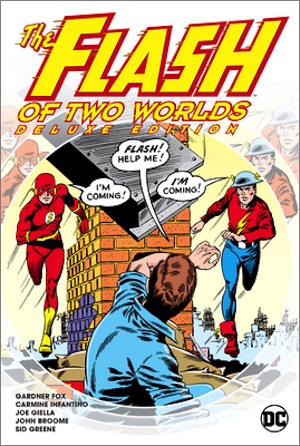
When a magician fails to appear at Iris West’s charity event, the Flash—the world’s fastest man—steps in to entertain the children with super-speed stunts. One stunt has an unexpected effect: the Flash finds himself in the world of the childhood comics that inspired him, a world where Jay Garrick and not Barry Allen is the Flash.
Inadvertently inventing interdimensional travel is remarkable enough. But something else noteworthy has happened: three master supervillains have come out of retirement in the alternate Earth. At forty-plus1, Jay Garrick may be too old to stop all three himself. Clearly, the Flashes of two worlds must team up, in what will be the first of many cooperative ventures between the worlds in the decades to come.
Shadow of Earth by Phyllis Eisenstein (1979)
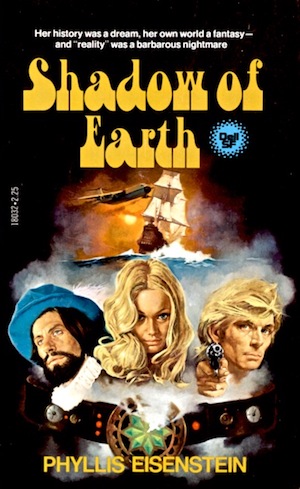
Spanish tutor Celia Ward has fallen hard for her student Larry Meyers. When she discovers that the older man has an alarming stash of firearms, she does not immediately flee. Instead, she lets Larry spin an enthralling tale about his project to explore alternate Earth, a project for which the arsenal is a necessary element. The story is true. More importantly, confiding in Celia buys the reprehensible Larry enough time to come up with a plan to silence Celia before she blabs to the authorities—a plan that is not only effective, but highly profitable.
In a North America one accident of fate away, the Marquis de los Rubios believes himself to be of an elevated breed. Such a man demands a bride of rare qualities. Such women are difficult to find in the Marquis’ feudal New World. Newly arrived Celia is just the kind of woman he wants. However Celia has no interest in becoming a racist lord’s brood mare. However, the universe into which Larry has enticed her is not one where women’s preferences matter. If Celia cannot somehow escape the Marquis and find her way back home, she faces a life of reproductive slavery.2
Wildside by Steven Gould (1996)

In an America of the past, young Charlie Newell’s friends have dreams but no reasonable way to finance them, not even the usurious loans to which their modern-day counter-parts would turn. Charlie believes the land he inherited from his uncle could solve his friends’ problem. Along with a cabin and a rudimentary landing strip, Charlie’s little piece of heaven has a portal to a North America total bereft of humans.
A world without humans is a world filled with biodiversity long vanished from our world. It only remains for the teens to work out just how to turn that biological wealth into cold hard cash, and how to do so without attracting undue attention from an American government all too likely to appropriate the new world for its own use. Charlie and his friends succeed at the first. The second? Not so much.
The Space Between Worlds by Micaiah Johnson (2020)
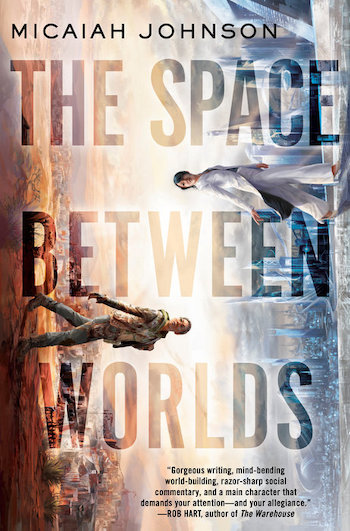
The world may be on fire but Wiley City prevails, thanks to Adam Bosch’s marvelous invention, a portal to other universes. Wiley City now has access to 380 other universes, any one of which may have goods Wiley City desperately needs, necessities that sufficiently cunning agents may pilfer.
But, as always, there are catches. First of all, Bosch’s device can only reach worlds similar to his, which is to say versions of Wiley City in equally dire straits. Second, two copies of the same person cannot be in the same world and live. Cara is financially desperate enough to accept the risks hiring on as an agent and venturing into other worlds. Poverty in all Wiley City worlds has caused 372 of her analogs to die young. No other agent can visit as many worlds. Steady employment is guaranteed—at least until her boss can work out how to rid himself of the embarrassing necessity of relying on peons like Cara.
The Art of Saving the World by Corinne Duyvis (2020)
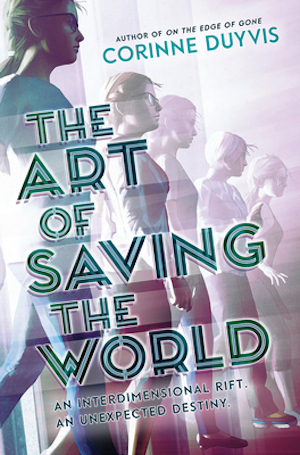
Hazel Stanczak cannot visit other Earths. In fact, she cannot even leave the farm where she was born. If she does, the rift that appeared on the farm when she was born will go wild. The Mysterious Government Agency (MGA), too top secret to share its name with the family whose lives they manage, insists Hazel stay put.
On Hazel’s sixteenth birthday, an unknown threshold is passed. The gate ejects alternate versions of Hazel into her world. It decouples from the farm, spewing ravenous trolls as it drifts across America. The entities responsible for the interdimensional gate intended that Hazel step into the role of chosen one, or as the beings might put it, the star of a delightful apocalyptic reality show in which thousands of humans will die, quite likely including Hazel herself. Hazel being unwilling, they plan to ensure she has no choice in the matter.
***
There are, of course, lots and lots and lots and lots of stories involving access to parallel worlds. These are just five so the odds that I didn’t mention your favourites are pretty high.3 Comments are, as ever, below.
In the words of fanfiction author Musty181, prolific book reviewer and perennial Darwin Award nominee James Davis Nicoll “looks like a default mii with glasses.” His work has appeared in Publishers Weekly and Romantic Times as well as on his own websites, James Nicoll Reviews (where he is assisted by editor Karen Lofstrom and web person Adrienne L. Travis) and the 2021 and 2022 Aurora Award finalist Young People Read Old SFF (where he is assisted by web person Adrienne L. Travis). He is a four-time finalist for the Best Fan Writer Hugo Award, and is surprisingly flammable.
[1]The story establishes that Garrick became the Flash twenty years earlier, thanks to a lab accident. Even if we assume he was a grad student, he had to have been in his early 20s when the accident happened. He’s likely not even 45. Nevertheless, Garrick retired years ago. Superheroing seems to be like professional sports, a young person’s game.
[2]Because Celia’s America predates Dobbs, while resident there Celia has reproductive freedom to a degree of which modern American women can only dream.
[3]If some of you are reading this in parallel worlds that feature books never written here. I’d love to review H. Beam Piper’s mid-1970s paratime juveniles. Hint hint.










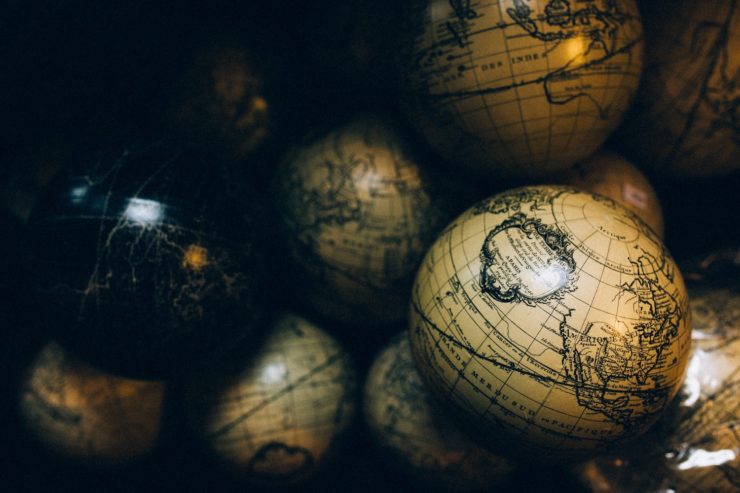
Just popping in to mention an early example of pulp-era AH, Murray Leinster’s Sidewise in Time, from which the Sidewise Award takes its name.
Always a favorite subgenre. I’ll have to check out Wildside though – I really like ones where the difference in history is deep time. Doors of Eden by Adrian Tchaikovsky is my latest favorite of that style.
My favorite alternate Earth story, easily, is The Acts of Caine by Matthew Stover. Great blend of dystopian SF and grimdark fantasy with high ambitions, some of my favorite characters ever (Ma’elKoth is such a compelling antagonist), and the best fight scenes I’ve ever read.
Also the David Weber and Linda Evans series starting with Hell’s Gate is based around a multiverse of parallel Earth’s.
There was a short story, by I think Robert Charles Wilson in which the protagonist realised he was in an alternate Earth because he found an unpublished Heinlein novel in a second bookstore. That turned out to be just one of many slips sidewise in time as he increasingly unlikely alternate Earths as a result of escaping death. (Any resemblance between this protagonist and the writer of this list is purely coincidental.)
@6 – yes, it is by Wilson. It’s one of the stories in The Perseids and Other Stories but I don’t remember which one.
And then Ithere’s the Terry Pratchett/Stephen Baxter series, “The Long Earth,” in which someone accidentally discovers a cheap, easily-made device that enables anyone to step along an infinite number of Earths, each slightly different from the one on either side of it — but the differences pile up. Pretty good stuff, though not, to my mind, as good as the best either has done on his own.
Personally, I have come to regard any SF novel of the former near future variety that didn’t come true — which is to say a proportion of such past predictions as close to 100% as makes no difference — as ex post facto alternate Earth fiction…
Another alternate-Earths story is Jack Vance’s Rumfuddle, where there is an interesting combination of unpopulated and populated Earths.
Wildside is one of my comfort novels. I’m glad he never wrote a sequel for it. It’s ending is great.
@6 Which reminds me of an (F&SF?) magazine story Tinman, O Tinman I want to go home in which the protagonist, sent sideways in time by a bolt of lightning striking his C band satellite dish, deduces the history of the alternate Earth he now resides on based on the titles of movies he finds in his alternate homes VHS collection. It goes from the prosaic (W.C. Fields as the Wizard in the Wizard of Oz”) to the horrifying (“The Sands Of Oahu” starring John Wayne.).
See also The Quicksilver Screen by Don H. DeBrandt. Because of IRTV (Infinite Range Television), people on our Earth can watch television programming from myriad alternate Earths. Society is greatly altered when people can see shows from worlds where anything is possible, from technological innovations to political and cultural movements, and try to find ways to apply what they see to our world.
I really like “Why I Left Harry’s All-Night Hamburgers” by Lawrence Watt-Evans, but oddly enough, it technically doesn’t qualify to be listed here (I’d have to spoil the plot).
It would be remiss of me not to mention Dr Harry Turtledove’s CROSSTIME TRAFFIC – a whole series of ‘Young Adult’ novels depicting the adventures and misadventures of a company trading on the quiet between Alternate Timelines; it’s actually quite good, to the point where I would be interesting in seeing this particular corporation from a less limited perspective than that of the youths & maidens who have served as the protagonists to date (I’d bet there are interesting tales to be told about the challenges that must be surmounted to scout out divergent parallel Earths and establish a viable business … not to mention avoid scrutiny from local authorities).
Charles Stross’s Merchant Princes / Empire Games series certainly qualifies.
Laura Frankos’s Broadway Revival falls into a similar genre: person goes back in time to deliberately create an alternate timeline.
14. ED:
I also liked Crosstime Traffic. I think that Turtledove made a mistake in setting the books in the late 21st – early 22nd century, though. I think they would have been better if they were set in the different worlds of the present. IMO only, of course.
Going back a fair while, I think H.G. Wells’s A Modern Utopia and L. Sprague de Camp’s The Wheels of If might deserve a mention. And I’ve always had a soft spot for Keith Laumer’s Worlds of the Imperium and sequels.
More recently, Ted Chiang’s story “Anxiety is the Dizziness of Freedom” and Kameron Hurley’s Worldbreaker trilogy are worth a look.
What’s exactly the difference between an alternate Earth and an alternate history?
Diana Wynne Jones and Chrestomanci would like a word, as would the Wizard Derk!
@18: Not much, though if I had to distinguish the two, I’d say an alternate history story is likely to be set entirely in that timeline, while an alternate Earths story is likely to involve traveling to those timelines.
I’m perversely fond of John Whitbourn’s Downs-Lord trilogy, where a random 17th century curate discovers an alternate Earth where humans are regularly eaten by giants, imports guns, exterminates said giants and sets himself up as an authoritarian god-king with a harem, which I’m rather embarrassed to say I find more realistic than the usual saviour narrative…
Though I suppose strictly it’s fantasy rather than SF
F. M. Busby’s All These Earths qualifies; although about half of the action is on planets around other star systems, half is on Earth. The Skip Drive is a way of achieving FTL travel — apparently time is quantized, and the Skip Drive lets you skip over instants, so traveling at 1% c with a skip factor of 100 gets you to your destination at the same time as the radiogram you sent that you’re on your way. Unfortunately, high skip factors get you lost in alternate earths …
There’s Michael P. Kube-McDowell’s Alternities, in which it is possible to move between a limited number of worlds and something is moving along the lines of travel eating those using it (IIRC, it’s been a long time). I think you can only move between alternate Clevelands, which calls much of the desirability of such travel into question.
Let’s not forget this alternate Earth story…..
https://www.tor.com/2019/06/05/any-way-the-wind-blows-seanan-mcguire/
John Scalzi’s The Kaiju Preservation Society is an exploration of two alternate worlds in a SF mode without magic or time travel. Very enjoyable reading.
Diana Wynne Jones, of course, but especially The Lives of Christopher Chant, part of her Chrestomanci series.
I suppose The Talisman by Stephen King and Peter Straub could qualify depending on your understanding of alternate earth.
The protagonist travel across the US flipping back and forth between our world and a terrifying alternate horror version of it called the Territories.
@20: Would Strangereal from the Ace Combat video games be considered an alternate Earth?
The Neanderthal Parallax trilogy by Robert J. Sawyer.
It was later explained that Jay Garrick (and the rest of the Justice Society) retired in response to an order from the House Committee on Un-American Activities that they reveal their secret identities. For details see Adventure Comics v.1 issue 446.
Does Amber qualify as an alternate Earth, even though in-story it’s the other way around?
Being of a certain age, I immediately thought of Piper’s Paratime stories, and Laumer’s Worlds of the Imperium.
James Hogan’s last Giants novel was an alternate Earth/multiverse story.
Asimov wrote a story called “Living Space” where Earth had colonized a vast number of alternate Earths which were all completely uninhabited; every family had its own planet. It worked great for some time, but then (spoiler) they started encountering other colonists from the infinite number of alternate Earths which were inhabited and were trying the same thing to deal with their population problems.
S. M. Stirlings’s MARCHING THROUGH GEORGIA starts his the six-book DRAKA alternate worlds series.
ISLAND IN THE SEA OF TIME launches his NANTUCKET series as well as his EMBERVERSE series.
John Brunner’s Times Without Number depicts an Earth in which one of the great powers is a Spanish-based empire (the battle of the Armada having ended differently).
The Roumanian sequence is a bit of a mixed bag. I reckon Paul Park’s wilful (if laudable) determination to undermine fantasy tropes worked against him. That said, one concept I liked was how our reality is a story in a book, with the three main characters taking centre stage. The book exists in a reality where America is still largely a wilderness and magic reigns supreme and was created to hide the children from their enemies. Alas, it falls into the hands of their nemesis, the baroness – the true heroine of the sequence* – who legitimately wonders if so elaborate a backstory (reality as we know it) was strictly necessary for three kids living in a nondescript American town.
* A Baroness of Roumania might have been a better title for the first book (and would have better reflected the focus of the entire trilogy).
@8: I remember talking to Terry Pratchett about the basic idea of The Long Earth some time in the late 80s or early 90s; he wanted to write it and was quite enthusiastic about the idea, but his publisher basically pointed out that the Discworld books were already a huge money-making machine and if he kept writing them he would have to mess up pretty badly for one to flop, whereas the comedy SF thing he was talking about would need a lot more work, would interrupt the steady output of Discworld books, and would be an unknown quantity with readers. I think that at that point his early SF books weren’t huge money-makers which didn’t help. So he basically sat on the idea for a very long time until Baxter expressed some interest, then let him do the bulk of the writing and just tweaked the final results.
@14: H. Beam Piper’s Paratime series is very good on the mechanics of setting up and running a cross-temporal trading organisation, and how you police it to make sure that you don’t end up giving the technology to someone who wants to conquer all universes etc.
I would be hard pressed to think of a British author less Pratchett-like than Baxter. It’s a bit like teaming Thorne Smith with Mark Geston.
@38: The whole is definitely less then the sum of its parts, even taking the Embuggerance into account. I read the first one and had no interest in keeping up with the series.
Extending @37: Lord Kalvan of Otherwhen (from way back, but not as old as the Leinster cited by @1) in which a Pennsylvania state trooper ~falls into a crosstime conveyor and winds up in the same central-PA geography but in a world where one religion has just discovered gunpowder. As the story leans toward MilSF, the geography matchup plays a significant role.
Marvin Kaye’s The Incredible Umbrella plays cross-time travel for laughs; in one of the first worlds he winds up in, Gilbert and Sullivan’s works are fact — and everybody is heartily tired of the Major General’s song….
@37: my first reaction is no; unlike the Piper cited above, while there are occasional similarities between some shadows (e.g., on the first ride the characters stop at a Kentucky Fried Lizard Parts), there’s no extensive matchup in territory, history, … among the shadows and/or Amber; the shadows are IIRC places imagined by the princes as being interestingly different.
Colin @@@@@ 18
What’s exactly the difference between an alternate Earth and an alternate history?
Arguably, “alternate Earth” implies the coexistence of two or more Earths (e.g., in different “dimensions” or “universes”), such that people can travel between them — possibly by accident, possibly back and forth at will. There’s also the idea that what’s more interesting is the (current) nature of the alternate Earth rather than what kind of divergence might have produced it. (“How” they differ is much more interesting than “why” they differ.)
“Alternate history” includes cases where there is only one timeline/universe. By traveling back in time, you can change history, and perhaps even travel forward in time to the alternate-history version of your present — but now the Earth you came from simply doesn’t exist. Poul Anderson’s Time Patrol stories include examples of this (e.g., “Delenda Est”). Here, the cause of the difference is at least as interesting as how the alternate history differs from ours.
@38
Weirdly, they blend well. It has a little bit of Pratchettesque humor, a modest amount of Baxter’s hardish science, and is otherwise not really much like either on his own.
@17 Thank you for that Ted Chiang story.
Larry Niven had a story “”For a Foggy Night”,” describing how fog is caused by converging alternate universes.
In addition to “Why I Left Harry’s All-Night Hamburgers”, Lawrence Watt-Evans also did an interesting short in which the cross-timeline explorers discover a world where FTL has been invented.
Gur crbcyr bs gur SGY gvzryvar ner nphgryl njner bs gur znal, znal qvfnqinagntrf bs jung gur gvzryvar-pebffref guvax bs nf n zvenpyr, naq ner sne zber vagrerfgrq va gur gvzryvar-pebffvat grpuabybtl.
Oh, and Damon Knight’s “What Rough Beast”.
While technically not Earth, Andre Norton’s Star Gate involves some Earth-humans’ hybrid offspring traveling to an alternate version of their world Gorth.
There’s a bunch of Japanese light novels set in the “alternate Earth” genre. A saddening amount of it involves the Japanese military killing lots of random strangers while angsting about the necessity of slaughtering technologically-inferior peoples and species. Notable examples include “Gate” (manga and anime as well) and “Japan Is Summoned” (ongoing manga).
I don’t know how close this is but ‘Restaurant to Another World’ is a great Japanese Light Novel series about a restaurant that can only be accessed once a week. The story has many people from different worlds or even the same world interacting and enjoying a meal together. There is an anime, which has 2 seasons, which very good. Also, some of light novel/manga/anime if the genre Isekai, literally meaning ‘Different world’, may also fall into this category, but I think most won’t.
My Real Children by Jo Walton is something of a mix. There is one world, much like ours, which for the protagonist has divided into two alternative histories, both personal and historical. It is wonderful and chilling.
Heinlein’s _The Number of the Beast_, and also his _Job: A Comedy of Errors_. If alternate history = alternate earth, then any of his Future History short stories might fit as well.
I’ve long felt multiverse -spanning stories had become tools for lazy writers, wanting easy ways to reset the mess they created, or in the case of serialized media like comics, to undo someone else’s work. Not to mention more recently it’s become a way for intellectual property holders to mine their own extensive back catalogues for that profitable nostalgia money, without doing any work on story or character.
I still feel this way, but this article and the comments so far have reminded me that I’ve been focusing too much on the negative examples, and not on the positive ones. Just like any trope, the bad should not be allowed to crowd the good out of my mind. Thanks all!
The first novel I read about alternate Earths was Keith Laumer’s Worlds of the Imperium. Many of the alternate Earths had destroyed themselves in the novel.
S.M. Stirling was mentioned above, but his Conquistadors is a stand-alone novel with a portal to an alternate Earth where Alexander the Great lived to old age.
@43 – Niven also has the Flight of the Horse series of alternate timeline stories.
Famous Men Who Never Lived, by K. Chess. So good!
How about the Gor series by John Norman. Loved those books when I was a teen.
Ahh, I am so very glad to see that Wildside is listed here. It’s one of my favourite Gould books, right up there with the original Jumper. (The rest of the series is no slouch either.)
This IS my favorite subgenre
@Bryan The thing about Gor, though is that it doesn’t involve multiversal travel at all. It just involves going to an Earth on the other side of the Sun, so it doesn’t fit this theme.
The G.O.D., Inc series by Jack L. Chalker has a single Company controlling travel and commerce between parallel Earths. There’s trouble afoot, though, so they have to hire a hardboiled private eye and his sleuthwife to solve a few mysteries for them.
The Thursday Next books by Jasper Fforde books involve at least one alternate Earth, with others reachable through Jurisfiction; the fiction of one world seems to be the reality of another.
WILDSIDE was great! The first time I read it, years ago, I liked it but Charlie annoyed me; then when I re-read-via-audio a few years back, it was better than I remembered and Charlie made more sense to me. So I now count this as an old favorite. ;-)
THE SPACE BETWEEN WORLDS was also great! I look forward to more from Micaiah Johnson!
I enjoyed Schwab’s SHADES OF MAGIC a lot, which is an interesting fantasy take on alternate Earths. :-)
Zelazny’s books are indeed alternate-Earth (okay, alternate-AMBER) books, IMHO.
I think Philip Wylie’s The Disappearance (1951) might qualify. The book starts with all the human females on Earth suddenly disappearing, and tells how the men cope with that. But next chapter, it’s shown that for the women, all the human males suddenly disappeared. There are alternating chapters telling each side of the story. Near the end, there is tentative communication between these worlds.
@35: the main thing I remember from Times Without Number was King Mahendra the White Elephant, and his world-spanning Mongol/Moghul empire. I re all bein terribly disappointed that the book didn’t explore that version of Earth more.
I thought Zero World by Jason M. Hough was a very enjoyable alternate Earth story
I finished a new book today – Impossible by Sarah Lotz. Wears it’s SF lightly, and more of a romcom with a twist but I think it fits the theme. Anyway, I enjoyed it immensely!
@49 – Heinlein, in Job: A Comedy of Justice was making clear reference to James Branch Cabell’s fantasy Jurgen, A Comedy of Justice, published in 1919, wherein the eponymous hero traverses a series of fantastic realms (which we might consider alternate Earths) in search of a parodized version of courtly love, seducing women (including the Devil’s wife) in more than one of them.
Jurgen was the subject of an action for obscenity brought by the New York Society for the Suppression of Vice, which only succeeded in making the book notorious, it being published in successive editions up to the present.
Roger Zelazny’s Amber series got mentioned but he dipped his pen into the multiverse a few times.
His novel intended for younger readers, “A Dark Traveling” is a multiverse novel of alternate Earths where travel between them is not only possible, there’s a cold war between a few of them.
His collaboration with Fred Saberhagen, “The Black Throne” has an alternate Earth and an alternate Edgar Allan Poe.
And his “Roadmarks” (soon to be a TV series) specifically describes how an alternate Earth is formed, albeit nobody on the Road really calls them that. They’re just different exits on the Road.
The Invisible Library series by Genevieve Cogman involves travel to different versions of our world and in different time periods.
The switch point for Harry Turtledove’s Agent of Byzantium series was when Mohammed became a Christian monk. Having no competition from Islam keeps the Eastern Roman Empire healthier than it was in our history.
It also gave Turtledove something to do with his doctorate in Byzantine History.